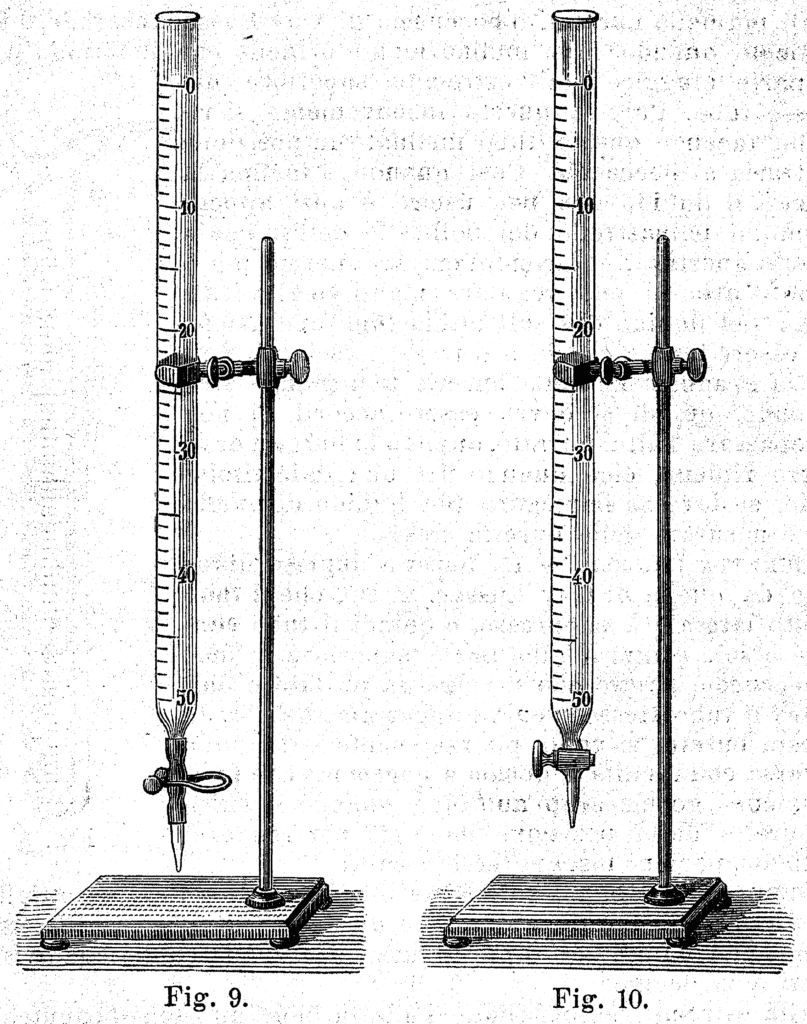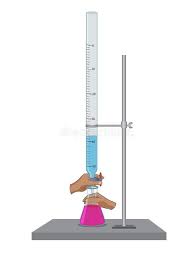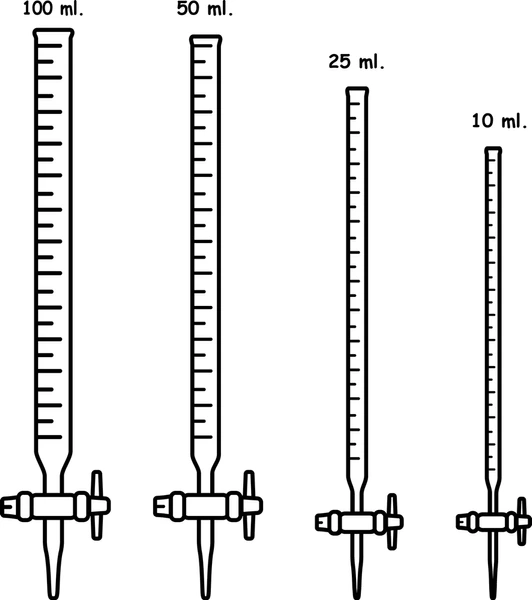Introduction:
A burette is one of the most precise and indispensable tools in laboratories, playing a crucial role in experiments involving titration and other volumetric analyses. Though simple in design, its functionality requires a keen understanding to ensure accurate results. This guide explores everything you need to know about burettes, including their types, uses, sizes, and maintenance, written with originality and depth to enrich your knowledge.

What Is a Burette?
A burette is a graduated glass or plastic tube with a stopcock at its lower end, used to deliver precise volumes of liquid during titration experiments. Its design ensures controlled release of liquid, allowing researchers to measure volume changes accurately, often to the nearest 0.01 milliliter (mL).
Key Features of a Burette:
- Graduated Markings: Typically marked in milliliters, enabling precise measurement.
- Stopcock: A valve at the bottom that controls the flow of liquid.
- Narrow Tube: Minimizes errors in volume reading.

Uses of Burettes
Burettes are widely employed in scientific and industrial settings. Common applications include:
- Titration Experiments:
- Used to add a titrant to a solution until the reaction reaches an endpoint, such as a color change.
- Essential in determining concentrations of acids, bases, or other analytes.
- Analytical Chemistry:
- Measurement of precise liquid volumes in quantitative analyses.
- Industrial Applications:
- Quality control in pharmaceuticals, food production, and chemical manufacturing.
- Educational Use:
- Teaching students about precision in measurement and the fundamentals of volumetric analysis.
How to Use a Burette Effectively
Using a burette requires careful attention to technique to achieve accurate results. Below is a step-by-step guide:
- Preparation:
- Ensure the burette is clean and free of residues. Wash with distilled water, followed by the liquid you’ll use, to prevent contamination.
- Mount the burette securely on a stand.
- Filling the Burette:
- Close the stopcock.
- Use a funnel to pour the liquid into the burette, ensuring the funnel does not drip during the process.
- Fill slightly above the zero mark and remove the funnel.
- Eliminating Air Bubbles:
- Open the stopcock briefly to let the liquid flow and remove any air bubbles in the tip.
- Reading the Meniscus:
- Eye level should be aligned with the liquid’s meniscus.
- Record the initial reading (usually at the bottom of the meniscus).
- Delivering Liquid:
- Turn the stopcock to release the liquid dropwise into the receiving container.
- Monitor the reaction (e.g., a color change) to determine the endpoint.
- Final Reading:
- Once the endpoint is reached, close the stopcock and record the final meniscus reading.
- Calculate the volume delivered by subtracting the initial reading from the final reading.
Types of Burettes
Burettes come in various designs, tailored for specific needs. Below are the main types:
- Glass Burettes:
- Material: Made from borosilicate glass.
- Use: Preferred for general laboratory use due to chemical resistance.
- Advantages: High accuracy and durability.
- Plastic Burettes:
- Material: Made from polyethylene or other plastics.
- Use: Suitable for fieldwork or experiments involving corrosive substances.
- Advantages: Lightweight and shatterproof.
- Digital Burettes:
- Description: Equipped with a digital display for volume readings.
- Use: Ideal for highly precise and automated measurements.
- Advantages: Eliminates human error in volume readings.
- Piston Burettes:
- Mechanism: Uses a piston to dispense liquid.
- Use: Suitable for viscous liquids or substances prone to evaporation.
- Advantages: Improved control over liquid flow.
- Micro Burettes:
- Description: Designed for very small volumes, often used in microliter-scale experiments.
- Use: Ideal for highly sensitive analytical work.
Sizes of Burettes
Burettes are available in various sizes to cater to different experimental needs. Common sizes include:
- Small-Volume Burettes:
- Capacity: 5 mL to 10 mL.
- Application: High-precision experiments requiring minimal liquid volumes.
- Standard Burettes:
- Capacity: 25 mL to 50 mL.
- Application: Widely used in general laboratory settings.
- Large-Volume Burettes:
- Capacity: Up to 100 mL.
- Application: Industrial and large-scale experiments.
Each size is typically marked with fine graduations, usually at intervals of 0.1 mL or finer, to ensure precision.

Materials Used in Burettes
The choice of material affects the durability and suitability of burettes for specific experiments. Common materials include:
- Borosilicate Glass:
- Resistant to heat and most chemicals.
- Provides clarity for accurate readings.
- Plastic (Polyethylene or Polypropylene):
- Chemically inert to acids and bases.
- Lightweight and shatterproof.
- Quartz Glass:
- Extremely heat-resistant and transparent.
- Used for specialized high-temperature applications.
Maintenance and Care of Burettes
Proper maintenance of burettes is crucial for accurate results and long service life. Follow these steps:
- Cleaning:
- Wash the burette immediately after use to prevent residue buildup.
- Use warm water and mild detergent, followed by a rinse with distilled water.
- Storage:
- Store upright in a burette rack to prevent bending or damage.
- Protect from direct sunlight if made of plastic, as UV exposure can degrade the material.
- Inspection:
- Regularly check for cracks, scratches, or damaged stopcocks.
- Replace damaged burettes to maintain safety and accuracy.
- Lubrication:
- Apply silicone grease to glass stopcocks for smooth operation.
Tips for Accurate Measurements with Burettes
- Calibrate Before Use:
- Periodically calibrate your burette against a standard volume to ensure accuracy.
- Avoid Parallax Errors:
- Always read the meniscus at eye level.
- Use Consistent Technique:
- Deliver liquid slowly and steadily, especially near the endpoint.
- Avoid Overfilling:
- Filling above the zero mark can lead to spillage and errors.

Advantages of Using Burettes
- Precision:
- Delivers highly accurate measurements.
- Versatility:
- Suitable for a wide range of liquids, including corrosive chemicals.
- Control:
- Stopcock design allows fine control over liquid flow.
- Reliability:
- Durable materials ensure consistent performance.
Fun Facts About Burettes
- Origins:
- The burette was invented in the 19th century by chemist Étienne Ossian Henry.
- Precision Tool:
- Modern burettes can measure liquid to an accuracy of 0.01 mL or better.
- Historical Significance:
- Played a pivotal role in the development of volumetric analysis techniques.
Conclusion
Burettes are essential tools for anyone involved in volumetric analysis, offering unmatched precision and versatility. By understanding their types, uses, and maintenance, you can ensure accurate and reliable results in your experiments. Whether you are a student or a professional chemist, mastering the use of burettes is a fundamental skill that will enhance your scientific pursuits.
